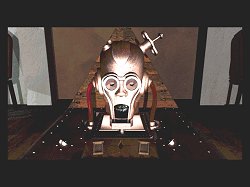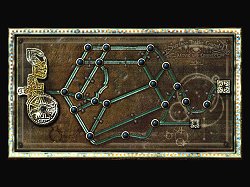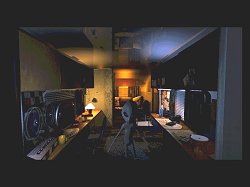|
Drowned God: Conspiracy of the Ages
 What do JFK, the Holy Grail, alien abductions and the tarot have in common? Or the movie Independence Day, Stonehenge, the 1992 British election, and French nuclear testing in the Pacific? The answer is the drowned god.
From the moment I entered my name in the Bequest Globe and generated my identity and secret number, and was told that my characteristics were that I was ordered, trustworthy, keen of mind and progressive (amongst others) I knew I was going to like this game.
Conspiracies can be fun, and whilst there are not many in this game that haven't been aired before, never has so much of the unexplained and mysterious been rolled into a single eon spanning secret. Nor at the end of the day has so much conspiracy-babble been presented in as entertaining a way. What do JFK, the Holy Grail, alien abductions and the tarot have in common? Or the movie Independence Day, Stonehenge, the 1992 British election, and French nuclear testing in the Pacific? The answer is the drowned god.
From the moment I entered my name in the Bequest Globe and generated my identity and secret number, and was told that my characteristics were that I was ordered, trustworthy, keen of mind and progressive (amongst others) I knew I was going to like this game.
Conspiracies can be fun, and whilst there are not many in this game that haven't been aired before, never has so much of the unexplained and mysterious been rolled into a single eon spanning secret. Nor at the end of the day has so much conspiracy-babble been presented in as entertaining a way.
It must be said up front that the X-Files and agent Mulder are clear and concise compared to the secrets of the drowned god. But ultimately it doesn't matter. The web of secrets and promised truths that is woven is compelling, and is constantly fed by more and more intrigue and deceit. The tit-bits revealed along the way make you want to continue, and whether or not you think you have finally uncovered the answers, the quest is one that draws you on.
That quest will take you to 4 alternate realms, as well as to Mayan pyramids, Stonehenge, lost submarines, a sideshow and a diner on Route 666. You will encounter Newton and Einstein, alien life forms, Morgan Le Fay, and a Pigman. You are looking for lost relics that have the capacity to create heaven on earth or Dante's hell. Two artificial intelligences provide information and the keys to the realms, and may or may not be enemies or allies, to you or each other. A disembodied voice also provides information in the form of poetic riddles. It is promised that if you find the relics and uncover the secrets, the truth will be revealed. To be successful, you must not only be thorough, you must complete some devious, and ingenious, puzzles.
 The puzzles may not all delight you, but nor do I think they will destroy you. Some took me well over an hour to complete, and much of that time was spent on working out the rules and objectives, usually through trial and error. However on almost every occasion I felt that I was making progress, and I never felt bogged down and hopelessly lost. Also, many of the puzzles can be completed independently, so you can walk away and go and do something else for a while, and come back and try again later. And if you do walk away, I cannot recall a single puzzle where what you had learnt about it on your previous attempt could not be put into practice next time around.
Some involve winning games against the computer or other adversaries, and practice makes perfect. Others require you to obtain an objective in a certain number of moves or attempts - failure means you start again, but each failed attempt will tell you something about how the puzzle works. In some you need to fail many times in order to know enough about the machine or object you are manipulating in order to be successful. The satisfaction level is exceedingly high when you do succeed.
There are also some more straightforward puzzles, that involve looking in the right place for the answer, or piecing together clues from various sources, or using the right inventory item. I know some players will be pleased to hear that there are no music or slider puzzles, although there are some (gentle) mazes.
Most are well integrated into the evolving storyline, confusing though that can be, but some stick out like a sore thumb. The latter though are not diminished in their enjoyment as a consequence. The puzzles may not all delight you, but nor do I think they will destroy you. Some took me well over an hour to complete, and much of that time was spent on working out the rules and objectives, usually through trial and error. However on almost every occasion I felt that I was making progress, and I never felt bogged down and hopelessly lost. Also, many of the puzzles can be completed independently, so you can walk away and go and do something else for a while, and come back and try again later. And if you do walk away, I cannot recall a single puzzle where what you had learnt about it on your previous attempt could not be put into practice next time around.
Some involve winning games against the computer or other adversaries, and practice makes perfect. Others require you to obtain an objective in a certain number of moves or attempts - failure means you start again, but each failed attempt will tell you something about how the puzzle works. In some you need to fail many times in order to know enough about the machine or object you are manipulating in order to be successful. The satisfaction level is exceedingly high when you do succeed.
There are also some more straightforward puzzles, that involve looking in the right place for the answer, or piecing together clues from various sources, or using the right inventory item. I know some players will be pleased to hear that there are no music or slider puzzles, although there are some (gentle) mazes.
Most are well integrated into the evolving storyline, confusing though that can be, but some stick out like a sore thumb. The latter though are not diminished in their enjoyment as a consequence.
The hunt for the relics takes place in wide and varied sets of environments, each with their own eclectic and at times mesmerising soundtracks. There is a watercoloured look about the landscapes and places, that adds to the shadowy and secretive feelings of the game.
 Movement is point and click, through 90 or 180 degrees, and at times you have to enter information through the keyboard. The cursor will indicate when there is a place or object you can interact with, but does not distinguish whether or not you can pick it up, manipulate it, use an inventory item on it, or simply look at it. You need to be a bit more cunning in inventory management, and look for visual and other clues as to where you can use items. If you can use an item with an object, the cursor will indicate this in the inventory (not the game view), if you open the inventory and select the item.
The game is littered with cut scenes and video sequences, many only accessed by examining everything. Not everything is essential to completing the game, but everything is worth having a look at. Do not try however to access the internet at the point where this option becomes available - the page no longer exists. Movement is point and click, through 90 or 180 degrees, and at times you have to enter information through the keyboard. The cursor will indicate when there is a place or object you can interact with, but does not distinguish whether or not you can pick it up, manipulate it, use an inventory item on it, or simply look at it. You need to be a bit more cunning in inventory management, and look for visual and other clues as to where you can use items. If you can use an item with an object, the cursor will indicate this in the inventory (not the game view), if you open the inventory and select the item.
The game is littered with cut scenes and video sequences, many only accessed by examining everything. Not everything is essential to completing the game, but everything is worth having a look at. Do not try however to access the internet at the point where this option becomes available - the page no longer exists.
There is no capacity to display dialogue, which is a shame because much of it is intriguingly, and at times beautifully, written. Also, against the background noise and soundtrack, at times it can be hard to hear, and it helps to pay attention to what you are told and there is only a limited capacity to have information repeated.
The game is contained on 3 CDs, and loaded without difficulty. You have to start the game each time though from the first CD. There are only 6 saved game slots, but you can back-up and restore saved games if you need to. I found 6 slots to be plenty.
Copyright © Steve Ramsey 2000.
All rights reserved.
I played the game having installed the most recent patch, and did not have a single lock-up or crash, nor did I encounter any bugs. Also, despite the modest system requirements, the game ran perfectly on a PIII at 800MHz with a 48x CD ROM without any tweaking or fiddling with configurations. Given the difficulty sometimes encountered running older games, this is a plus worth mentioning.
|
